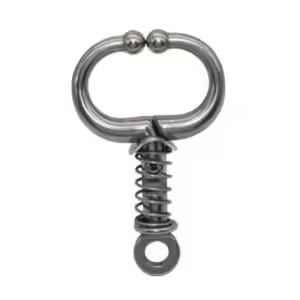Using a cow lifter hip clamp is an effective and humane way to assist downed cows, promoting their recovery and ensuring the safety and well-being of both the animal and the handler.
Key Features
- Heavy-Duty Construction: Made from high-strength steel or other durable materials to withstand the weight of large cattle.
- Adjustable Clamps: Features adjustable clamps that can be customized to fit various sizes of cows securely and comfortably.
- Padding for Comfort: Includes padding or rubberized grips on the clamps to minimize discomfort and prevent injury to the cow.
- Hoist Compatibility: Designed to be used with various hoisting systems, including chains, ropes, and mechanical lifts.
- Easy Operation: Simple mechanism for quick attachment and release, making it user-friendly.
- Rust and Corrosion Resistant: Coated with rust-resistant materials to ensure durability and longevity, even in harsh farm environments.
Benefits
- Assists Recovery: Helps lift and support cows that are unable to stand, aiding in their recovery and preventing further injury.
- Improves Safety: Enhances the safety of both the animal and the handler by providing a secure and controlled lifting method.
- Versatile Use: Suitable for various situations, including post-calving recovery, injury management, and illness treatment.
- Reduces Labor: Reduces the physical strain on farmers and veterinarians by providing mechanical assistance in lifting heavy animals.
- Durability: Built to last, offering reliable performance over multiple uses.
- Enhanced Animal Welfare: Provides a humane way to assist downed cows, minimizing stress and discomfort.
How to Use
- Preparation:
- Ensure the cow lifter hip clamp is clean and in good working condition.
- Choose an appropriate hoisting system compatible with the clamp.
- Calm the cow and position it in a stable, secure area to prevent further stress or injury.
- Attachment:
- Adjust the clamps to fit the cow’s hip bones securely.
- Position the clamps on either side of the cow’s pelvis, just above the hip bones.
- Tighten the clamps carefully, ensuring a snug fit without causing discomfort or injury.
- Lifting:
- Attach the lifting equipment (chains, ropes, or mechanical lift) to the clamps.
- Slowly and steadily lift the cow, ensuring it remains balanced and secure.
- Monitor the cow’s response during lifting, adjusting the process as needed to minimize stress.
- Supporting the Cow:
- Once the cow is lifted, support it in an upright position to promote circulation and recovery.
- Allow the cow to bear some weight on its legs if possible, gradually assisting it to stand.
- Monitor the cow’s condition and provide necessary medical treatment or rest periods.
- Release:
- Carefully lower the cow back to the ground when it is ready or when treatment is complete.
- Gently release the clamps, ensuring the cow is stable before fully removing the lifting equipment.
- Maintenance:
- Clean and disinfect the cow lifter hip clamp after each use to prevent infection and maintain hygiene.
- Inspect the clamps and frame for any signs of wear or damage, repairing or replacing parts as needed.
- Store the clamp in a dry, secure place to prevent rust and ensure it is ready for future use.
Discover more from The Kisan
Subscribe to get the latest posts sent to your email.












Reviews
There are no reviews yet.